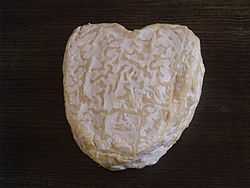| French Neufchâtel |
|---|
 |
| Country of origin |
France |
|---|
| Region, town |
Haute-Normandie, Neufchâtel-en-Bray |
|---|
| Source of milk |
Cows |
|---|
| Pasteurised |
No |
|---|
| Texture |
Soft |
|---|
| Aging time |
8–10 weeks |
|---|
| Certification |
AOC, 1969 |
|---|
Neufchâtel is a soft, slightly crumbly, mould-ripened cheese made in the French region of Normandy. One of the oldest cheeses in France, its production is believed to date back to the 6th century. It looks similar to Camembert, with a dry, white, edible rind, but the taste is saltier and sharper. It has the aroma and taste of mushrooms. Unlike other soft-white-rinded cheeses, Neufchâtel has a grainy texture.[1] It is most usually sold in heart shapes but is also produced in other forms, such as logs and boxes. It is typically matured for 8–10 weeks.
American Neufchâtel
In 1872, William Lawrence, a New York dairyman of the township of Chester, created the first American cream cheese as the result of an attempt to create a batch of Neufchâtel. This American Neufchâtel is softer than regular cream cheese due to its approximately 33% lower fat and higher moisture content.[2][3] Due to this reduced fat content, it is found in most grocery stores as a reduced-fat option to cream cheese. In the United States, this Neufchâtel is sometimes called farmers' cheese.[4]
References
|
|---|
| | | | Types | | |
|---|
| | Animal milk |
- Cow
- Goat
- Reindeer
- Sheep
- Water buffalo
- Yak
|
|---|
| | Regions | |
|---|
| | Special designations | |
|---|
| | Organizations | |
|---|
| |
|

